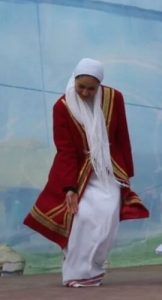




S.S. Tatubayev notes [8] that the greeting gestures of Kazakhs differ between women and men, i.e. are socially relevant.
For girls, the ritual for greeting older people consists of slightly tilting the head and placing the hand palm down in the solar plexus area. The left hand is lowered or pulled back slightly, and the eyes are usually lowered. Here it draws attention to the figuration of the right hand – the symbol of woman and the main “acting” hand – and its application to the solar plexus – the sacred part of the body in Eastern cultures, associated with the element of fire and the sun (for example, the chakras). Among Kazakhs, the area of the girl’s solar plexus was decorated with jewelry and clothing rich in ornaments and usually with solar symbolism. Lowered eyes are a sign of modesty and education.
The female gesture of greeting, especially to the father-in-law, mother-in-law and older brothers of the husband, called “sälem etu” is filled with deep symbolism. This gesture is described by S.S. Tatubayev as follows: a woman bends to the ground with her left knee, hands are placed one over the other on the right knee [9, с. 68].
Kazakh culture is characterized by a special reverence for elders, and especially for kelin (daughter-in-law), towards older family members, which is supported by traditional etiquette. The first “sälem etu” or “sälem salu” takes place during the wedding ceremony “betashar”. Each bow of the new bride was accompanied by a precious gift from the groom’s relatives. The origins of the later gestures to greet the husband’s relatives and the ceremony to avoid them go back to an archaic taboo – the prohibition of incest.


